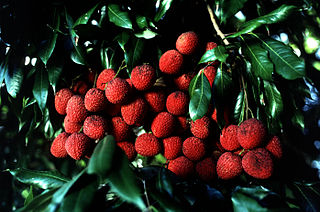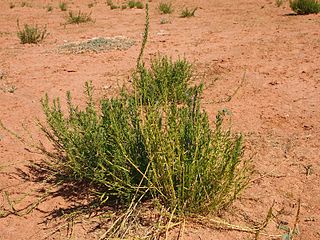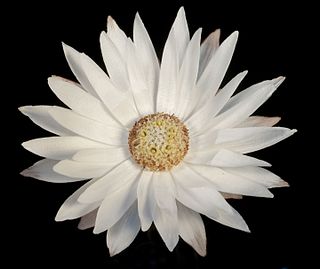Related Research Articles

The Sapindaceae are a family of flowering plants in the order Sapindales known as the soapberry family. It contains 138 genera and 1858 accepted species. Examples include horse chestnut, maples, ackee and lychee.

Aleurites is a small genus of arborescent flowering plants in the Euphorbiaceae, first described as a genus in 1776. It is native to China, the Indian Subcontinent, Southeast Asia, Papuasia, and Queensland. It is also reportedly naturalized on various islands as well as scattered locations in Africa, South America, and Florida.

Cenchrus is a widespread genus of plants in the grass family. Its species are native to many countries in Asia, Africa, Australia, the Americas, and various oceanic islands.

Balaustion is a monotypic genus of flowering plants in the myrtle family, Myrtaceae. The sole species is Balaustion pulcherrimum, commonly known as the native pomegranate, which is endemic to Western Australia.

Vachellia nilotica, more commonly known as Acacia nilotica, and by the vernacular names of gum arabic tree, babul, thorn mimosa, Egyptian acacia or thorny acacia, is a flowering tree in the family Fabaceae. It is native to Africa, the Middle East and the Indian subcontinent. It is also considered a 'weed of national significance' and an invasive species of concern in Australia), as well as a noxious weed by the federal government of the United States.

Banksia proteoides, commonly known as king dryandra, is a shrub endemic to Western Australia. It was known as Dryandra proteoides until 2007, when all Dryandra species were transferred to Banksia by Austin Mast and Kevin Thiele.

Santalum album, or Indian sandalwood, is a small tropical tree, and the traditional source of sandalwood oil. It is native to southern India and Southeast Asia. It is considered sacred in some religions like Hinduism, and some cultures place great significance on its fragrant and medicinal qualities. However, the high value of the species has caused over-exploitation, to the point where the wild population is vulnerable to extinction. Indian sandalwood still commands high prices for its essential oil owing to its high alpha santalol content, but due to lack of sizable trees it is no longer used for fine woodworking as before. The plant is long-lived, but harvest is only viable after many years.

Senna artemisioides, the wormwood senna, is a species of flowering plant in the pea family Fabaceae. It is endemic to Australia, where it is found in all mainland states and territories. Other common names include silver senna, silver cassia or feathery cassia - although "cassia" generally refers to the largest-growing Cassiinae. Some of its distinct subspecies also have common names of their own.

Sowerbaea is a small genus of perennial herbs which are endemic to Australia.

Stemodia is a genus of flowering plants in the family Plantaginaceae. The genus comprises approximately 40 species of annual and perennial herbs and shrubs which are distributed throughout temperate and tropical regions of Asia, Africa, Australia and the Americas. This genus is sometimes placed in the families Scrophulariaceae or Gratiolaceae. The generic name is derived from the Latin word stemodiacra, which means "stamens with two tips." Twintip is a common name for several species.

Aphanopetalum is a genus of twining shrubs or vines in the family Aphanopetalaceae which are endemic to Australia.

The flora of Western Australia comprises 10,551 published native vascular plant species and a further 1,131 unpublished species. They occur within 1,543 genera from 211 families; there are also 1,317 naturalised alien or invasive plant species more commonly known as weeds. There are an estimated 150,000 cryptogam species or nonvascular plants which include lichens, and fungi although only 1,786 species have been published, with 948 algae and 672 lichen the majority.

Acidonia microcarpa is a species of shrub in the plant family Proteaceae. It is the only species in the genus Acidonia. It is endemic to the south coast of the Southwest Botanic Province of Western Australia.

Dichopogon is a genus of perennial herbs, native to Australia and New Guinea. It is included in the genus Arthropodium by some authorities, although recognized as a distinct genus by others. In the APG III classification system, it is placed in the family Asparagaceae, subfamily Lomandroideae.

Argentipallium is a genus of flowering plants in the family Asteraceae. The genus, which is endemic to Australia, was first formally described in 1992 by Paul G. Wilson in the botanical journal Nutsyia.
Beilschmiedia bancroftii is a tree species in the family Lauraceae. It is native to Queensland in Australia. Common names include yellow walnut, yellow nut and canary ash.

Embelia is a genus of climbing shrubs once placed in the family Myrsinaceae, which is now included in the Primulaceae. There are about 130 species which occur in tropical and subtropical areas across a wide range including Africa and Madagascar and from eastern Asia to the Pacific Islands as well as Australia including:
Hypolaena is a plant genus in the family Restionaceae, described as a genus in 1810. The entire genus is endemic to Australia.

Franklandia fucifolia, or lanoline bush, is native to the south-west of Western Australia. It is a species in the Franklandia genus of the Proteaceae family.

Rhodanthe battii is a plant in the Asteraceae family, native to Western Australia.